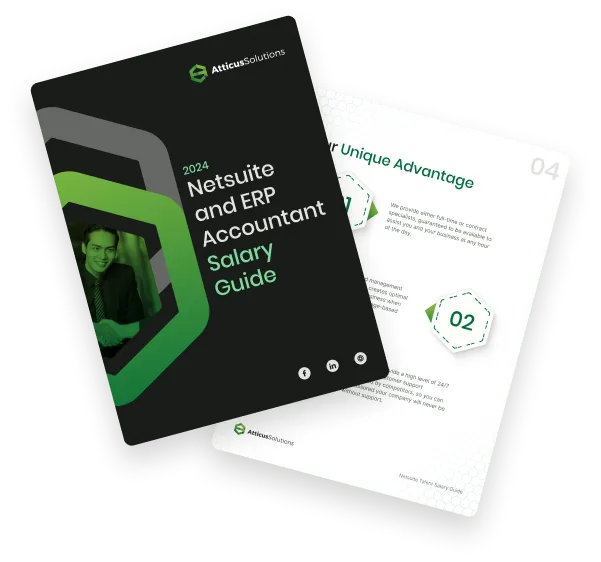7 Custom Workflows Your NetSuite Accountant Needs & How to Set Them Up

Your NetSuite system is powerful—but are you actually using it that way? Most companies we talk to are sitting on a gold mine of automation potential while their accounting team drowns in manual processes.
Here's what we see daily: Your AP clerk manually chasing down approvals for vendor bills. Your controller spending hours reconciling accounts that could be matched automatically. Your finance team creating the same custom reports every month because nobody set up a proper dashboard.
This isn't a NetSuite problem. It's a workflow problem.
Custom workflows are the difference between a NetSuite system that just stores your financial data and one that actively manages your financial processes. With the right NetSuite accountant guiding these setups, you can eliminate those Friday night month-end scrambles and the constant "where is this invoice?" questions.
In this article, we'll walk you through 7 essential workflows that every NetSuite accounting system should have—and exactly how to set them up.
These aren't theoretical nice-to-haves. These are the actual workflows we implement for our clients that cut processing time in half and catch costly errors before they happen.
Let's fix your NetSuite accounting system today.
Workflow #1: Vendor Bill Approval Process

Close-up of a person with a credit card at a laptop, highlighting a quick tip to avoid duplicate payments.
Ever watch an invoice sit on someone's desk for weeks while the vendor calls repeatedly asking when they'll get paid? Or worse, discover you've paid the same bill twice because no one tracked the approval status? This approval chaos isn't just a bottleneck—it's expensive.
A proper vendor bill workflow in NetSuite creates a digital paper trail that prevents these problems entirely. Here's how to set it up:
First, map your actual approval hierarchy. Don't just copy your org chart—follow the money. Who really needs to approve what? For most companies, we recommend:
- Level 1: Department managers approve bills under $5,000
- Level 2: Directors approve $5,000-$25,000
- Level 3: C-suite approves anything over $25,000
Next, build conditional routing. When a bill hits NetSuite, it should automatically go to the right approver based on amount, department, and vendor type. No more guessing or manual forwarding.
The groundbreaking shift is adding validation rules that flag duplicate invoices, unexpected price increases, or missing PO numbers before they even reach approvers. This prevents those awkward "why did we approve this?" conversations later.
Quick Tip: The One Setting That Prevents Duplicate Payments
Turn on "Vendor Bill Number Uniqueness" in your Accounting Preferences AND set it to warn by vendor. This simple toggle stops duplicate payments instantly by alerting your team when the same invoice number appears twice from the same vendor.
Workflow #2: Expense Report Processing

Expense reports create friction at every level of your organization. Your employees delay submitting them until the last minute, your finance team spends valuable time tracking down missing documentation, and your managers face a pile of approvals that always seem to arrive at month-end.
A smart NetSuite expense workflow fixes all this by front-loading the requirements:
Start with mobile-first submission. Your sales team should be able to snap photos of receipts on their phone the moment they get them. Configure the NetSuite mobile app to require receipt images before submission is even possible.
Next, add policy compliance flags that automatically check expenses against your rules. Hotel charge over the per-night limit? Flag it. Meal without attendee names? Flag it. This catches violations before they hit approvers.
The secret is creating a time-based escalation path. If an expense sits unapproved for more than 3 days, it automatically escalates to the next level. This prevents the all-too-common scenario of reports sitting in approval limbo for weeks.
Finally, connect the workflow to your corporate card feed. When expenses get approved, they should automatically match to card transactions, eliminating reconciliation headaches.
Quick Tip: How to Set Up Mobile Expense Submissions That Actually Work
Configure the "Required Fields" section in Expense Report preferences to make receipt image, expense category, and date mandatory at the line-item level. This prevents incomplete submissions and cuts follow-up questions by 70%.
Workflow #3: Revenue Recognition Automation

Revenue recognition might be the most stressful part of your financial process. When done manually, it's a breeding ground for errors that can lead to misstatements and compliance issues.
Your NetSuite accountant can set up a workflow that handles even complex revenue scenarios automatically. Here's what it should include:
Start with contract categorization. Your workflow should automatically classify different revenue types based on delivery method, subscription terms, or project milestones. This ensures consistent treatment across similar contracts.
Then build recognition triggers based on real events in your business. Product shipped? Services delivered? Milestone achieved? These system events should automatically drive the recognition schedule without manual intervention.
The most valuable piece is exception handling. When something doesn't fit the standard pattern—a partial delivery, service change, or early termination—the workflow should flag it for review rather than incorrectly processing it.
Connect the workflow to your billing process so changes in one area automatically update the other. This prevents the classic problem of recognized revenue not matching what you've billed.
Quick Tip: The 3-Step Test for Revenue Recognition Accuracy
Set up a saved search that compares three key metrics monthly: total recognized revenue, total billed revenue, and total deferred revenue changes. If the sum doesn't balance, you have recognition issues to investigate.
Workflow #4: Month-End Close Checklist

Your month-end close doesn't need to be a mad dash of late nights and takeout dinners. A proper NetSuite close workflow transforms this chaos into a structured process everyone can follow.
Build a dynamic task list that assigns specific activities to team members. Each task should include clear instructions, dependencies, and links to the exact NetSuite screens needed to complete it.
Add validation checkpoints between major sections. Is the balance sheet reconciled before income statement work begins? Did bank accounts match before the cash flow analysis? These checkpoints prevent cascading errors.
The workflow should include time tracking for each task. This data helps you identify bottlenecks and measure improvements over time. Most of our clients cut close time by 40% within three months of implementing this tracking.
Incorporate document collection directly into the workflow. Bank statements, reconciliation reports, and supporting schedules should all be attached to the relevant tasks, creating a complete audit trail in one place.
Quick Tip: How to Cut Your Month-End Close Time by 40%
Create a "Pre-Close" workflow that runs daily during the last week of the month. This mini-checklist handles accruals, preliminary reconciliations, and other tasks that don't need to wait until month-end. When the month actually closes, you're already halfway done.
Workflow #5: Cash Flow Forecasting

Cash flow surprises are business killers. One week you're comfortable; the next you're scrambling to cover payroll. A good NetSuite cash flow workflow gives you visibility weeks ahead of any potential crunch.
Build your workflow around actual transactional data, not just projections. Connect your AR aging, approved POs, and payment schedules to create a day-by-day view of incoming and outgoing cash.
Add probability weighting to your AR. Not all receivables pay on time, so your workflow should apply historical payment patterns to forecast more accurately. If a customer typically pays 15 days late, your forecast should reflect this reality.
The key difference-maker is including non-accounting data. Incorporate sales pipeline stages, project completion percentages, and inventory ordering patterns. These leading indicators make your forecast much more reliable than traditional accounting-only models.
Set up alert thresholds that notify your team when projected balances fall below comfort levels. This early warning system gives you time to adjust spending or accelerate collections before you hit a crisis point.
Quick Tip: The Cash Flow Dashboard Your CFO Will Thank You For
Create a dashboard with three time horizons: 30-day cash position (daily detail), 90-day trend (weekly detail), and 12-month outlook (monthly detail). This gives you both tactical and strategic visibility in one view.
Workflow #6: Inventory Reconciliation

Inventory discrepancies cause major headaches - from shipping delays to unexpected P&L hits when you finally count everything. A proper NetSuite inventory workflow catches these issues daily, not just at year-end.
Start with cycle count scheduling that prioritizes high-value and high-velocity items. Your workflow should automatically generate count tasks based on item value, turnover rate, and days since last count.
Add variance triggers that flag suspicious movements. If an item suddenly shows unusual activity - a 200% increase in usage or a negative quantity - the system should flag it for immediate review rather than waiting for your next scheduled count.
The most valuable component is connecting physical counts to GL impact analysis. When discrepancies are found, your workflow should estimate the financial impact before adjustments are made, allowing for proper review of material variances.
Include location transfers in your reconciliation scope. Many inventory discrepancies happen during transfers between warehouses or locations, not during sales or receiving.
Quick Tip: Automatic Variance Detection That Actually Works
Set up a daily saved search that compares theoretical inventory (beginning balance + receipts - sales - known adjustments) to system quantity on hand. Any difference indicates a transaction was entered incorrectly or missed entirely.
Workflow #7: Financial Compliance Tracking

Missing a tax deadline or compliance filing can cost you thousands in penalties. A NetSuite compliance workflow keeps these critical dates from falling through the cracks.
Create a central compliance calendar that tracks all your filing requirements—sales tax returns, income tax estimates, 1099 reporting, and industry-specific filings. Each requirement should include responsible parties, documentation needs, and lead time for preparation.
Connect this calendar to your team's task list so deadlines automatically appear on the right person's dashboard. No more relying on someone to remember that quarterly filing.
The most valuable feature is document storage integration. When a filing is completed, the workflow should prompt for confirmation documentation—submission receipts, confirmation numbers, or acknowledgment letters—and store them with the task record.
Add status reporting that gives your leadership team visibility into upcoming obligations and completion status. This transparency eliminates those "did we file that?" moments during board meetings.
Quick Tip: The Compliance Calendar Every NetSuite Accountant Uses
Create a saved search with "compliance" as a custom transaction type. Add fields for jurisdiction, filing frequency, next due date, and last filing date. This gives you a sortable, filterable view of all your obligations in one place.
Conclusion
These seven workflows aren't just nice-to-haves—they're the difference between a NetSuite system that just stores your transactions and one that actively manages your financial processes.
The real question isn't whether you need these workflows. It's whether your team has the NetSuite expertise to build them correctly.
At Atticus, our NetSuite accountants don't just understand accounting—they understand how to make NetSuite work for your specific business processes. We've built these exact workflows for companies like yours, cutting their processing time in half and eliminating those costly errors that keep you up at night.
Want to see how your current NetSuite setup measures up? Schedule your consultation with Atticus today. We'll review your system and show you exactly which workflows would make the biggest impact for your team.
Frequently Asked Questions

Compare NetSuite ERP talent salaries
Attracting top NetSuite talent with clear job descriptions is the first step. Understanding salaries is your next key move! Download this free salary guide to view talent costs, offshore hiring tips, and more
Learn how to scale your business

What is Your Strategy for Finding Rare Skill Sets like NetSuite Accountants?
Join our talented team. We are a small, passionate team with a commitment to hiring the best.



